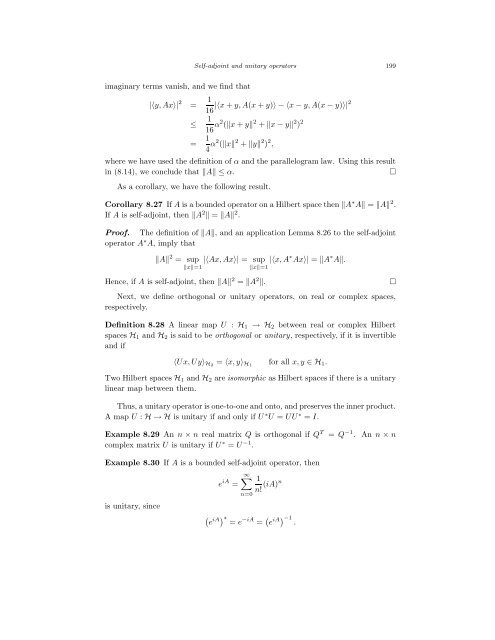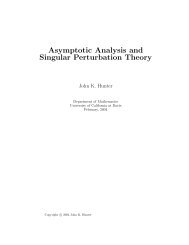Bounded Linear Operators on a Hilbert Space
Bounded Linear Operators on a Hilbert Space
Bounded Linear Operators on a Hilbert Space
You also want an ePaper? Increase the reach of your titles
YUMPU automatically turns print PDFs into web optimized ePapers that Google loves.
imaginary terms vanish, and we find that<br />
Self-adjoint and unitary operators 199<br />
|〈y, Ax〉| 2 = 1<br />
|〈x + y, A(x + y)〉 − 〈x − y, A(x − y)〉|2<br />
16<br />
≤ 1<br />
16 α2 (x + y 2 + x − y 2 ) 2<br />
= 1<br />
4 α2 (x 2 + y 2 ) 2 ,<br />
where we have used the definiti<strong>on</strong> of α and the parallelogram law. Using this result<br />
in (8.14), we c<strong>on</strong>clude that A ≤ α. <br />
As a corollary, we have the following result.<br />
Corollary 8.27 If A is a bounded operator <strong>on</strong> a <strong>Hilbert</strong> space then A ∗ A = A 2 .<br />
If A is self-adjoint, then A 2 = A 2 .<br />
Proof. The definiti<strong>on</strong> of A, and an applicati<strong>on</strong> Lemma 8.26 to the self-adjoint<br />
operator A ∗ A, imply that<br />
A 2 = sup |〈Ax, Ax〉| = sup |〈x, A<br />
x=1<br />
x=1<br />
∗ Ax〉| = A ∗ A.<br />
Hence, if A is self-adjoint, then A 2 = A 2 . <br />
Next, we define orthog<strong>on</strong>al or unitary operators, <strong>on</strong> real or complex spaces,<br />
respectively.<br />
Definiti<strong>on</strong> 8.28 A linear map U : H1 → H2 between real or complex <strong>Hilbert</strong><br />
spaces H1 and H2 is said to be orthog<strong>on</strong>al or unitary, respectively, if it is invertible<br />
and if<br />
〈Ux, Uy〉H2 = 〈x, y〉H1<br />
for all x, y ∈ H1.<br />
Two <strong>Hilbert</strong> spaces H1 and H2 are isomorphic as <strong>Hilbert</strong> spaces if there is a unitary<br />
linear map between them.<br />
Thus, a unitary operator is <strong>on</strong>e-to-<strong>on</strong>e and <strong>on</strong>to, and preserves the inner product.<br />
A map U : H → H is unitary if and <strong>on</strong>ly if U ∗ U = UU ∗ = I.<br />
Example 8.29 An n × n real matrix Q is orthog<strong>on</strong>al if Q T = Q −1 . An n × n<br />
complex matrix U is unitary if U ∗ = U −1 .<br />
Example 8.30 If A is a bounded self-adjoint operator, then<br />
e iA ∞ 1<br />
=<br />
n! (iA)n<br />
is unitary, since<br />
n=0<br />
e iA ∗ = e −iA = e iA −1 .
















